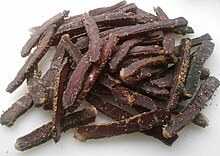hpr3912 :: Emergency Show: Biltong and Rooibos
Shane brings us a taste of South Africa with some local tea and jerky

Hosted by Shane Shennan on 2023-08-01 is flagged as Clean and is released under a CC-BY-SA license.
South Africa, Biltong, Rooibos, Afrikaans.
(Be the first).
The show is available on the Internet Archive at: https://archive.org/details/hpr3912
Listen in ogg,
spx,
or mp3 format. Play now:
Duration: 00:03:53
general.
Biltong
From Wikipedia, the free encyclopedia
Biltong is a form of dried, cured meat which originated in Southern African countries (South Africa, Zimbabwe, Malawi, Namibia, Botswana, Eswatini and Zambia). Various types of meat are used to produce it, ranging from beef to game meats such as ostrich or kudu. The cut may also vary being either fillets of meat cut into strips following the grain of the muscle, or flat pieces sliced across the grain. It is related to beef jerky; both are spiced, dried meats; however the typical ingredients, taste, and production processes may differ.
The word "biltong" is from the Dutch bil ("buttock") and tong ("strip" or "tongue").
Rooibos
From Wikipedia, the free encyclopedia
Rooibos, meaning "red bush"), or Aspalathus linearis, is a broom -like member of the plant family Fabaceae that grows in South Africa 's fynbos biome.
The leaves are used to make a herbal tea that is called rooibos (especially in Southern Africa), bush tea , red tea , or redbush tea (predominantly in Great Britain).
The tea has been popular in Southern Africa for generations, and since the 2000s has gained popularity internationally. The tea has an earthy flavour that is similar to yerba mate or tobacco .
Rooibos was formerly classified as Psoralea but is now thought to be part of Aspalathus following Dahlgren (1980). The specific name of linearis was given by Burman (1759) for the plant's linear growing structure and needle-like leaves.


